MITSUBISHI COLT 2008 Owner's Manual (in English)
Manufacturer: MITSUBISHI, Model Year: 2008, Model line: COLT, Model: MITSUBISHI COLT 2008Pages: 450, PDF Size: 14.57 MB
Page 101 of 450
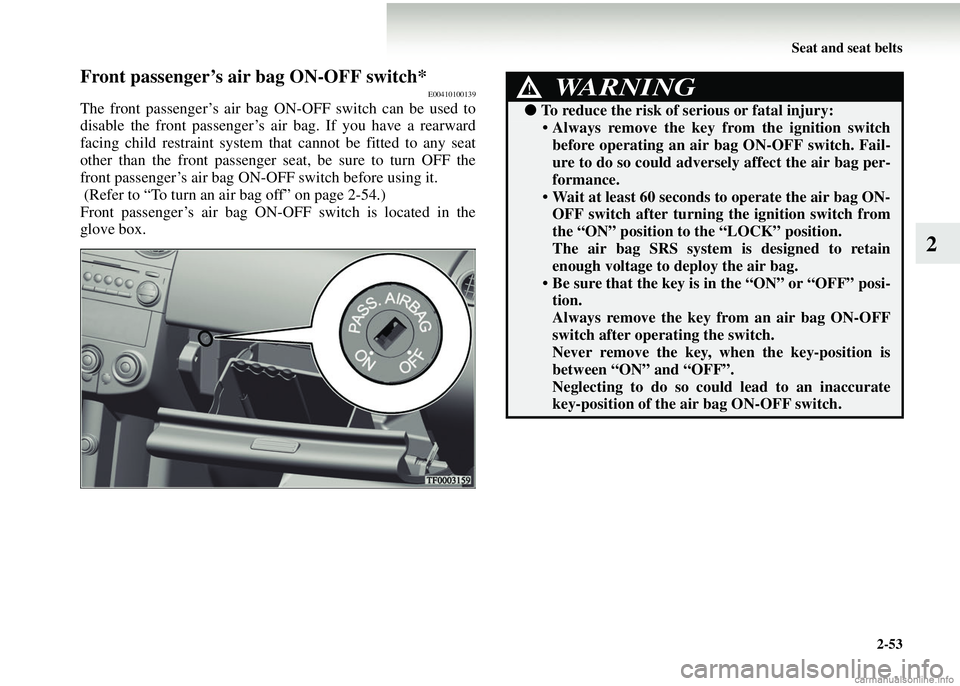
Seat and seat belts2-53
2
Front passenger’s air bag ON-OFF switch*E00410100139
The front passenger’s air bag ON-OFF switch can be used to
disable the front passenger’s air bag. If you have a rearward
facing child restraint system that cannot be fitted to any seat
other than the front passenger seat, be sure to turn OFF the
front passenger’s air bag ON-OFF switch before using it.
(Refer to “To turn an air bag off” on page 2-54.)
Front passenger’s air bag ON-OFF switch is located in the
glove box.
WARNING!
●To reduce the risk of serious or fatal injury:
• Always remove the key from the ignition switch
before operating an air bag ON-OFF switch. Fail-
ure to do so could adversely affect the air bag per-
formance.
• Wait at least 60 seconds to operate the air bag ON- OFF switch after turning the ignition switch from
the “ON” position to the “LOCK” position.
The air bag SRS system is designed to retain
enough voltage to deploy the air bag.
• Be sure that the key is in the “ON” or “OFF” posi- tion.
Always remove the key from an air bag ON-OFF
switch after operating the switch.
Never remove the key, when the key-position is
between “ON” and “OFF”.
Neglecting to do so coul d lead to an inaccurate
key-position of the air bag ON-OFF switch.
Page 102 of 450
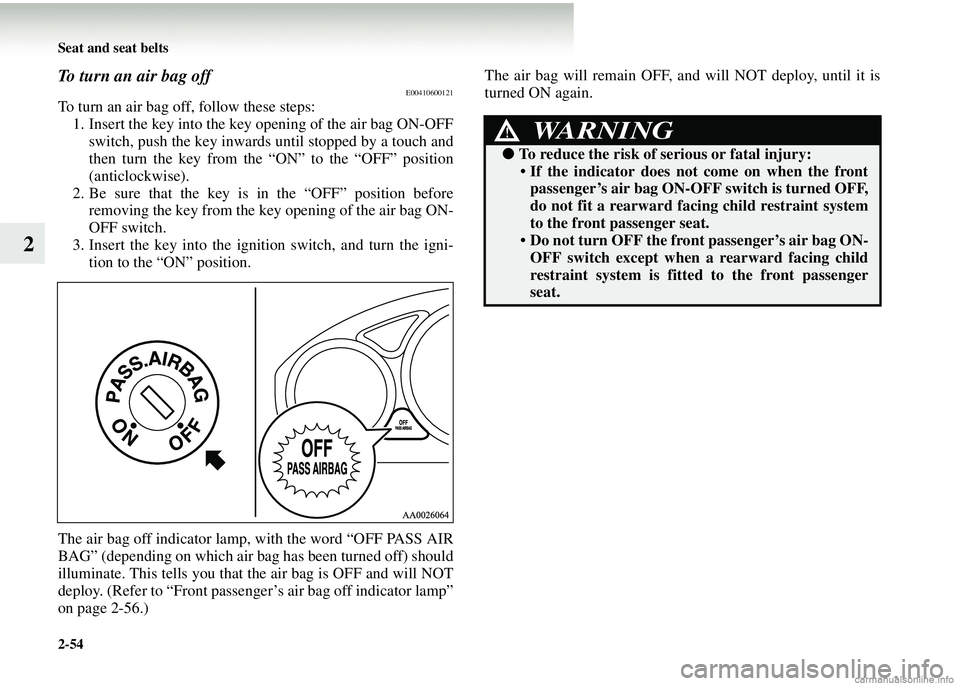
2-54 Seat and seat belts
2
To turn an air bag offE00410600121
To turn an air bag off, follow these steps:1. Insert the key into the key opening of the air bag ON-OFF
switch, push the key inwards until stopped by a touch and
then turn the key from the “ON” to the “OFF” position
(anticlockwise).
2. Be sure that the key is in the “OFF” position before removing the key from the key opening of the air bag ON-
OFF switch.
3. Insert the key into the ignition switch, and turn the igni- tion to the “ON” position.
The air bag off indicator lamp, with the word “OFF PASS AIR
BAG” (depending on which air bag has been turned off) should
illuminate. This tells you that the air bag is OFF and will NOT
deploy. (Refer to “Front passenger’s air bag off indicator lamp”
on page 2-56.) The air bag will remain OFF, and will NOT deploy, until it is
turned ON again.
WARNING!
●
To reduce the risk of serious or fatal injury:
• If the indicator does not come on when the front
passenger’s air bag ON-OFF switch is turned OFF,
do not fit a rearward facing child restraint system
to the front passenger seat.
• Do not turn OFF the fron t passenger’s air bag ON-
OFF switch except when a rearward facing child
restraint system is fitt ed to the front passenger
seat.
Page 103 of 450
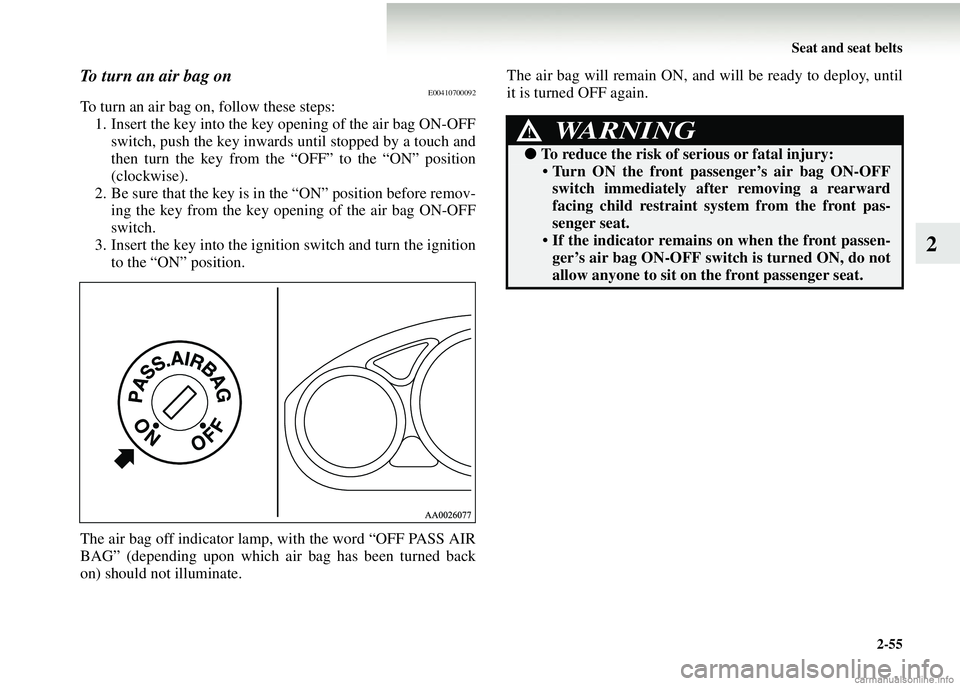
Seat and seat belts2-55
2
To turn an air bag onE00410700092
To turn an air bag on, follow these steps:1. Insert the key into the key opening of the air bag ON-OFF
switch, push the key inwards until stopped by a touch and
then turn the key from the “OFF” to the “ON” position
(clockwise).
2. Be sure that the key is in the “ON” position before remov- ing the key from the key opening of the air bag ON-OFF
switch.
3. Insert the key into the ignition switch and turn the ignition to the “ON” position.
The air bag off indicator lamp, with the word “OFF PASS AIR
BAG” (depending upon which air bag has been turned back
on) should not illuminate. The air bag will remain ON, and will be ready to deploy, until
it is turned OFF again.
WARNING!
●
To reduce the risk of serious or fatal injury:
• Turn ON the front passenger’s air bag ON-OFF
switch immediately after removing a rearward
facing child restraint sy stem from the front pas-
senger seat.
• If the indicator remains on when the front passen- ger’s air bag ON-OFF switch is turned ON, do not
allow anyone to sit on the front passenger seat.
Page 104 of 450
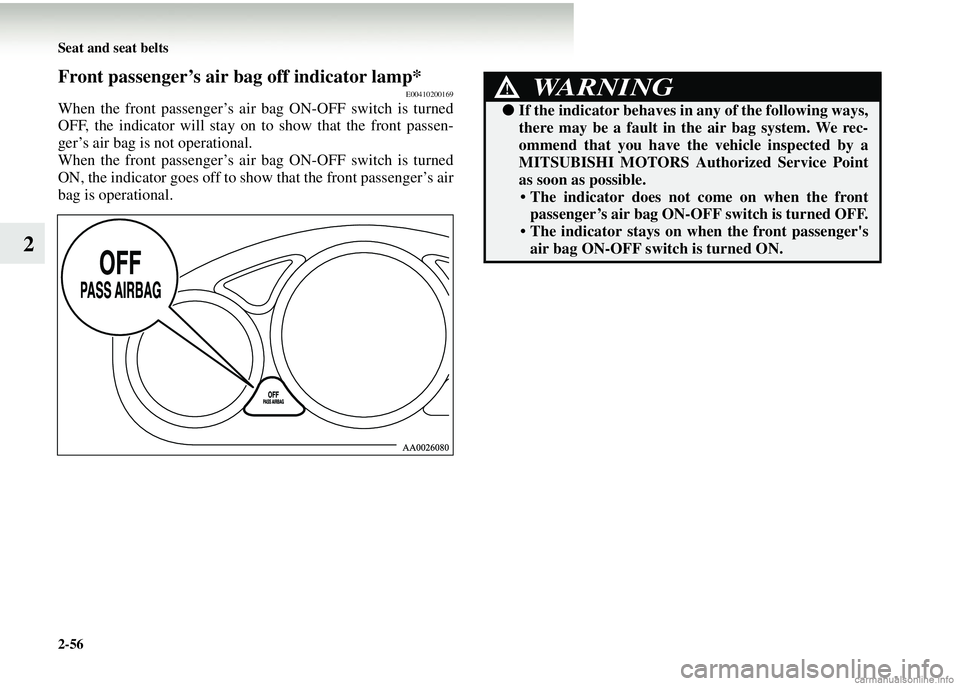
2-56 Seat and seat belts
2
Front passenger’s air bag off indicator lamp*E00410200169
When the front passenger’s air bag ON-OFF switch is turned
OFF, the indicator will stay on to show that the front passen-
ger’s air bag is not operational.
When the front passenger’s air bag ON-OFF switch is turned
ON, the indicator goes off to show that the front passenger’s air
bag is operational.
WARNING!
● If the indicator behaves in any of the following ways,
there may be a fault in the air bag system. We rec-
ommend that you have th e vehicle inspected by a
MITSUBISHI MOTORS Auth orized Service Point
as soon as possible.
• The indicator does not come on when the front passenger’s air bag ON-OFF switch is turned OFF.
• The indicator stays on when the front passenger's
air bag ON-OFF switch is turned ON.
Page 105 of 450
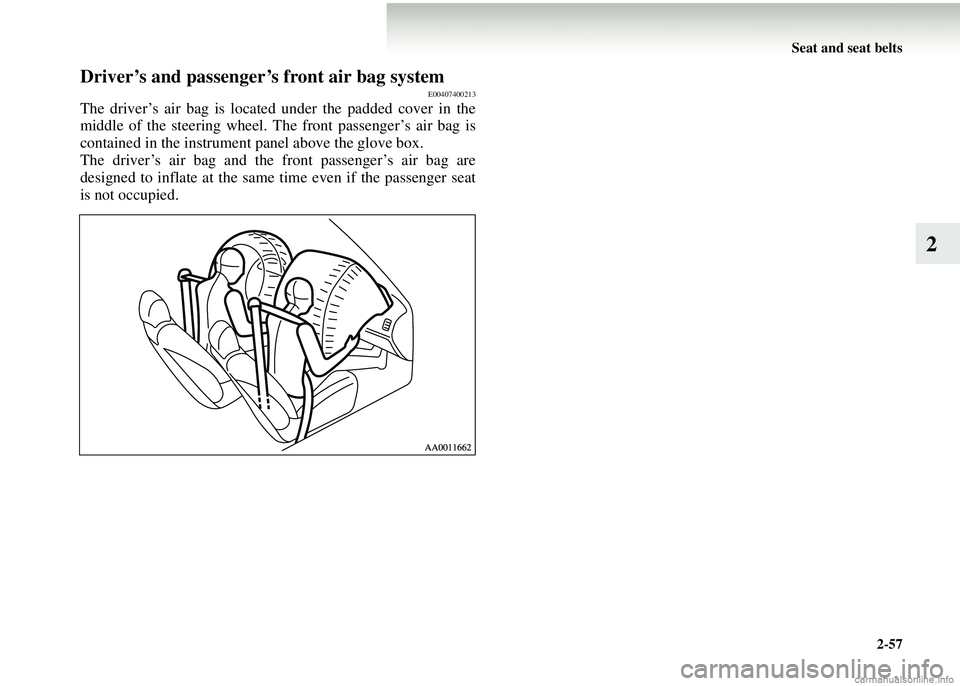
Seat and seat belts2-57
2
Driver’s and passenger’s front air bag systemE00407400213
The driver’s air bag is located under the padded cover in the
middle of the steering wheel. Th e front passenger’s air bag is
contained in the instrument panel above the glove box.
The driver’s air bag and the front passenger’s air bag are
designed to inflate at the same time even if the passenger seat
is not occupied.
Page 106 of 450
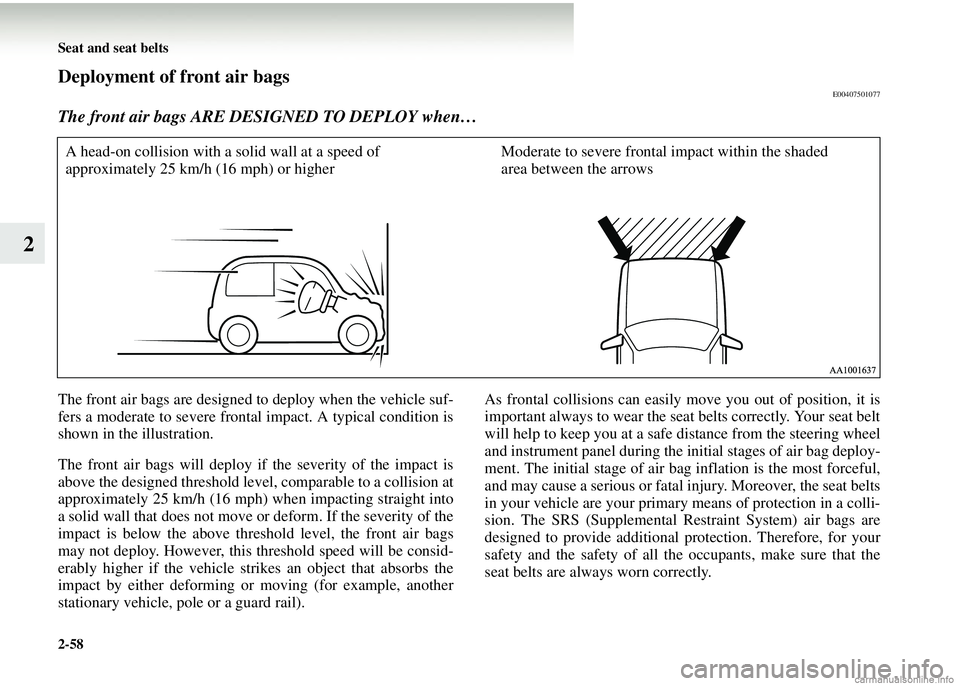
2-58 Seat and seat belts
2
Deployment of front air bagsE00407501077
The front air bags ARE DESIGNED TO DEPLOY when…
The front air bags are designed to deploy when the vehicle suf-
fers a moderate to severe frontal impact. A typical condition is
shown in the illustration.
The front air bags will deploy if the severity of the impact is
above the designed threshold level, comparable to a collision at
approximately 25 km/h (16 mph) when impacting straight into
a solid wall that does not move or deform. If the severity of the
impact is below the above threshold level, the front air bags
may not deploy. However, this threshold speed will be consid-
erably higher if the vehicle stri kes an object that absorbs the
impact by either deforming or moving (for example, another
stationary vehicle, pole or a guard rail). As frontal collisions can easily move you out of position, it is
important always to w
ear the seat belts correctly. Your seat belt
will help to keep you at a sa fe distance from the steering wheel
and instrument panel during the initial stages of air bag deploy-
ment. The initial stage of air bag inflation is the most forceful,
and may cause a serious or fatal injury. Moreover, the seat belts
in your vehicle are your primary means of protection in a colli-
sion. The SRS (Supplemental Re straint System) air bags are
designed to provide additional protection. Therefore, for your
safety and the safety of all the occupants, make sure that the
seat belts are always worn correctly.
A head-on collision with a solid wall at a speed of
approximately 25 km/h (16 mph) or higher Moderate to severe frontal impact within the shaded
area between the arrows
Page 107 of 450
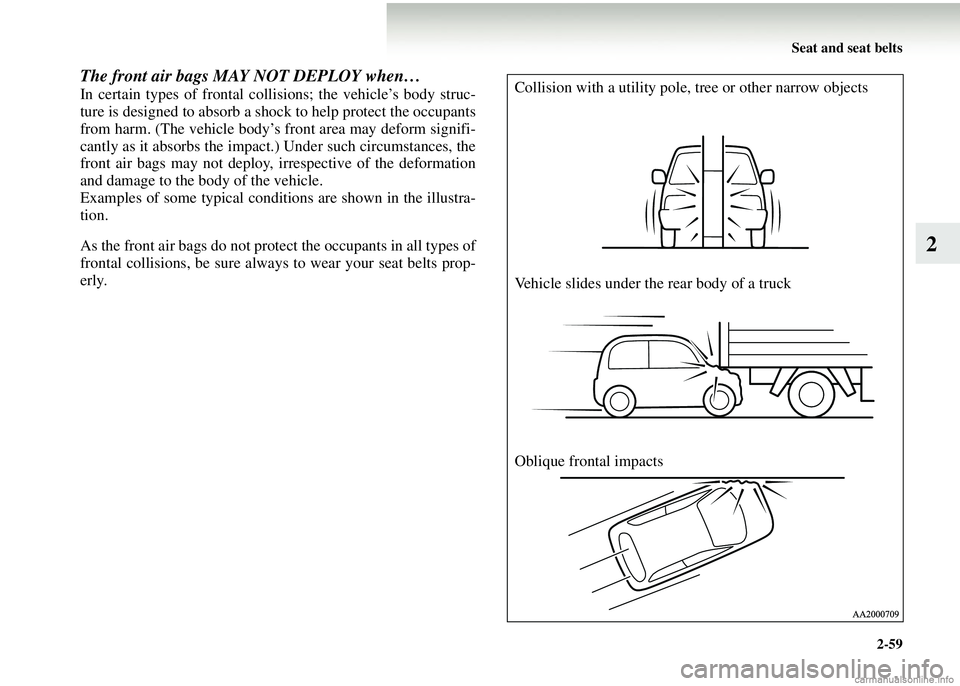
Seat and seat belts2-59
2
The front air bags MAY NOT DEPLOY when…
In certain types of frontal collisions; the vehicle’s body struc-
ture is designed to absorb a shock to help protect the occupants
from harm. (The vehicle body’s front area may deform signifi-
cantly as it absorbs the impact.) Under such circumstances, the
front air bags may not deploy, irrespective of the deformation
and damage to the body of the vehicle.
Examples of some typical conditions are shown in the illustra-
tion.
As the front air bags do not prot ect the occupants in all types of
frontal collisions, be sure always to wear your seat belts prop-
erly.Collision with a utility pole, tree or other narrow objects
Vehicle slides under the rear body of a truck
Oblique frontal impacts
Page 108 of 450
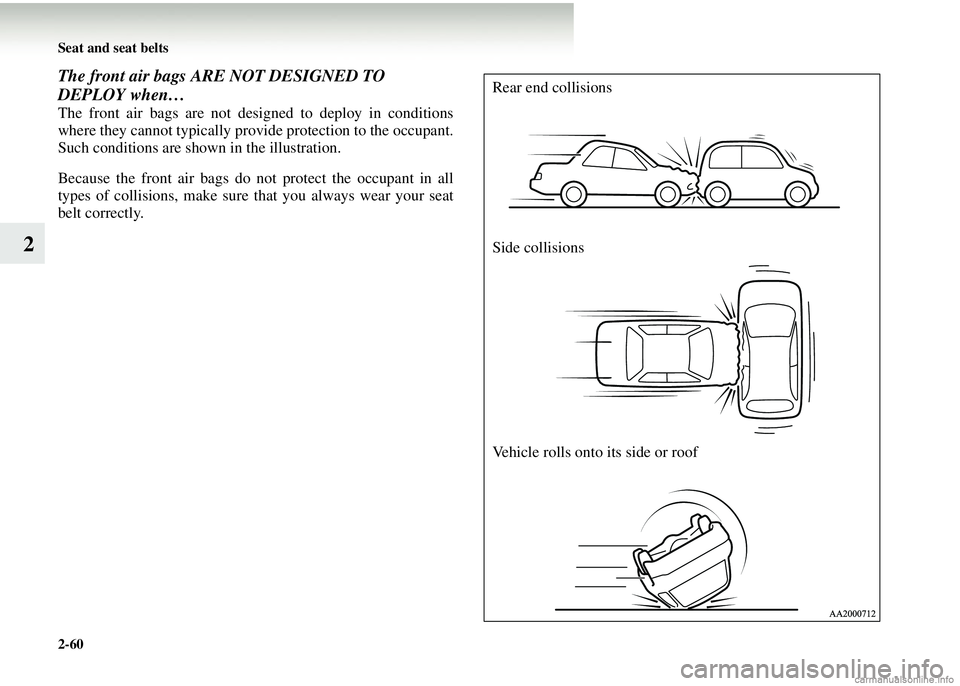
2-60 Seat and seat belts
2
The front air bags ARE NOT DESIGNED TO
DEPLOY when…
The front air bags are not designed to deploy in conditions
where they cannot typically provide protection to the occupant.
Such conditions are shown in the illustration.
Because the front air bags do not protect the occupant in all
types of collisions, make sure that you always wear your seat
belt correctly.
Side collisions
Vehicle rolls onto its side or roof Rear end collisions
Page 109 of 450
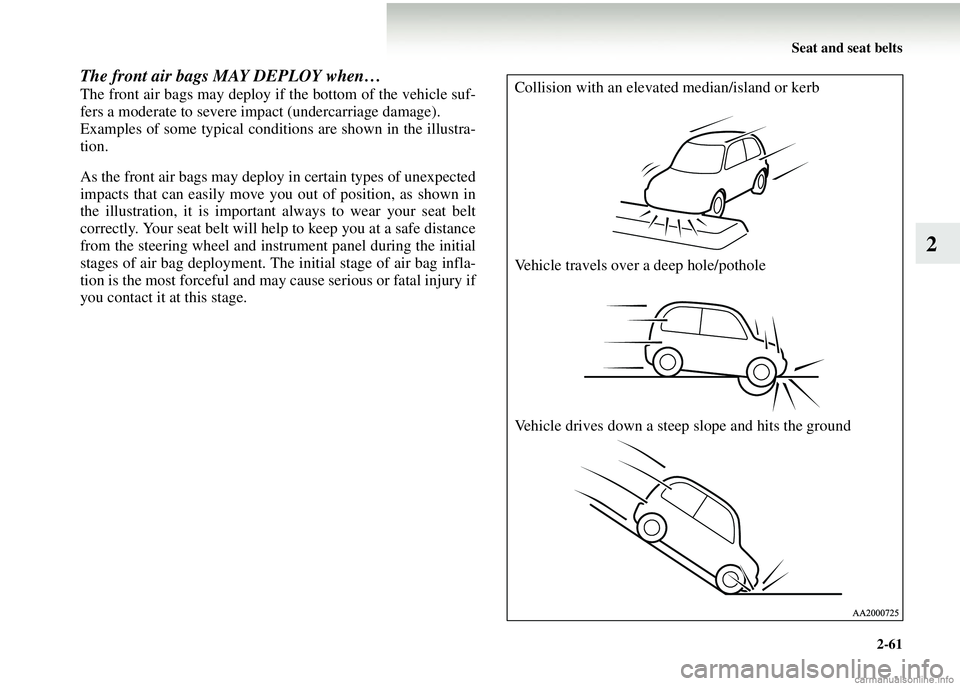
Seat and seat belts2-61
2
The front air bags MAY DEPLOY when…
The front air bags may deploy if the bottom of the vehicle suf-
fers a moderate to severe impact (undercarriage damage).
Examples of some typical conditions are shown in the illustra-
tion.
As the front air bags may deploy in certain types of unexpected
impacts that can easily move you out of position, as shown in
the illustration, it is important always to wear your seat belt
correctly. Your seat belt will help to keep you at a safe distance
from the steering wheel and instrument panel during the initial
stages of air bag deployment. The initial stage of air bag infla-
tion is the most forceful and may cause serious or fatal injury if
you contact it at this stage.Collision with an elevated median/island or kerb
Vehicle travels over a deep hole/pothole
Vehicle drives down a steep slope and hits the ground
Page 110 of 450
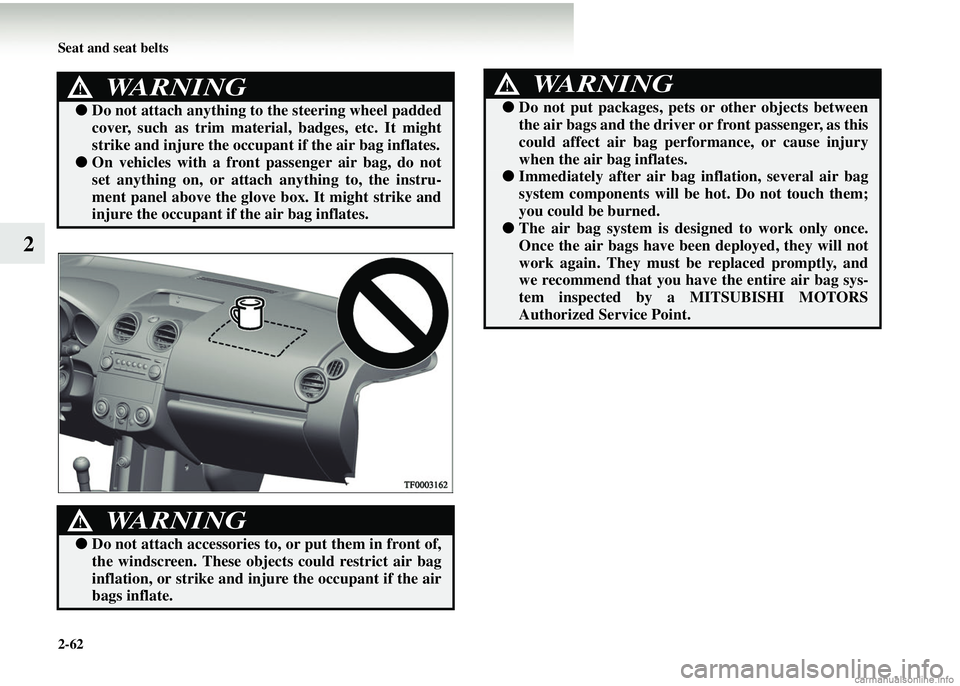
2-62 Seat and seat belts
2
WARNING!
●Do not attach anything to the steering wheel padded
cover, such as trim materi al, badges, etc. It might
strike and injure the occupa nt if the air bag inflates.
●On vehicles with a front passenger air bag, do not
set anything on, or attach anything to, the instru-
ment panel above the glove box. It might strike and
injure the occupant if the air bag inflates.
WARNING!
● Do not attach accessories to , or put them in front of,
the windscreen. These objects could restrict air bag
inflation, or strike and injure the occupant if the air
bags inflate.
● Do not put packages, pets or other objects between
the air bags and the driver or front passenger, as this
could affect air bag perf ormance, or cause injury
when the air bag inflates.
● Immediately after air bag inflation, several air bag
system components will be hot. Do not touch them;
you could be burned.
●The air bag system is desi gned to work only once.
Once the air bags have been deployed, they will not
work again. They must be replaced promptly, and
we recommend that you have the entire air bag sys-
tem inspected by a MITSUBISHI MOTORS
Authorized Service Point.
WARNING!